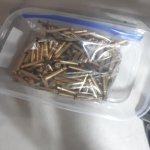There are some who think that “
brass is brass”. In fact, not so. Brass is an alloy of Copper and Zinc (plus potentially a small amount of other stuff). Copper is really soft, but has some great properties for ammo cartridges – including its ability to respond to forces and pressures by stretching and springing back. Adding zinc to the mix makes the resultant alloy stronger and the strongest brass will have more than 39% Zinc. However, adding more than 30% Zinc can make it harder to form the cases – requiring extra heat and forces – adding to manufacturing costs. Balancing out these considerations, cartridge brass is supposed to be 70% Copper and 30% Zinc (see Wikipedia
CLICK ON LINK).
As noted, while it is possible to make cartridge case with more than 30% Zinc – you may need better forming equipment and you’ll incur more production costs (even though the cost of the material itself – Zinc – is actually cheaper than Copper).
Various CGN posts have established that not all factory ammo brass is created equal. People report that some newer brass, used in commercial US ammo, is almost useless for reloading; inasmuch as many people have said that their once fired cases seem to suffer head separations after a few reloadings. Lots of folks get sucked into the belief that this situation is because there is something wrong with their gun – and its “
bad headspacing” – but knowledgeable shooters are increasingly recognizing that is probably just a cover story for the fact that the brass in their factory ammo isn’t made to last for much more than the original firing.
There are stories from other non CGN posts where people claim that they have written to Remington, Winchester etc. about this and have been specifically told, by such OEMs, that their factory ammo cases aren’t intended to be reloaded. This is starting to make sense. Its looking likely that US ammo manufacturers are using sub-grade brass – with WAY less than 30% Zinc for making ammo where strength is less important. For example, an ammo maker with a worn-out, or less powerful case forming machine might choose to deploy this to make cases for 303 British ammo and compensate for the limitations of that machinery by feeding it with sub grade brass containing say, only 20% Zinc (or less!).
Is this the problem with the particular type of once fired cases that are giving you grief? To find your answer you could go to Oak Island and get them to test the metallurgy of your cartridge cases, using their XRF (“
X-Ray Fluorescence Spectrometer”) machine. If Marty and Rick say “
no”, you could send your cases to another lab. You might find the results are interesting, as shown, for example, in this article (CLICK ON
THIS LINK ).
If neither of these options works for you, you could get an idea of how much Zinc is in the alloy mix for your brass by just looking at it. If the stuff is a really pretty, honey gold colour – with a lot of red shades – sorry, but your brass is probably LOW-grade stuff – with too much Copper and not enough Zinc. If your cases have more of a gray color, it is going to have more Zinc content. Otherwise, if you remember any of your high school science classes – and remember what “
density” is – and if you know how to measure density – you can figure-out the quality of your brass, using a container of water to measure the volume of the material that makes-up the case and a scale to figure-out the weight of that displaced water.
Hint: if the specific gravity of the brass in the cases you are using is less than 8.392, your brass is at least standard cartridge quality. If it is more than that – sorry, but your brass is soft JUNK – that was probably never intended to last more than one firing.









































































